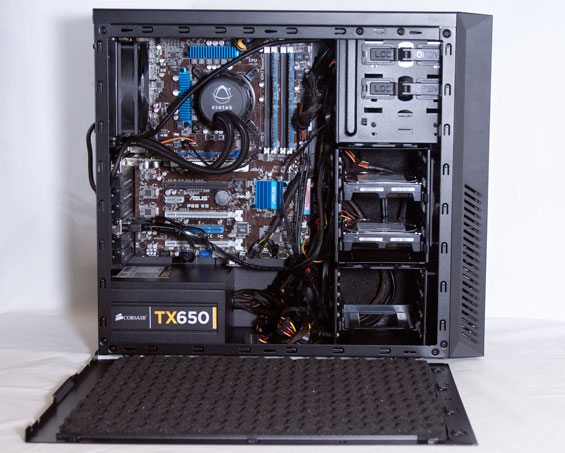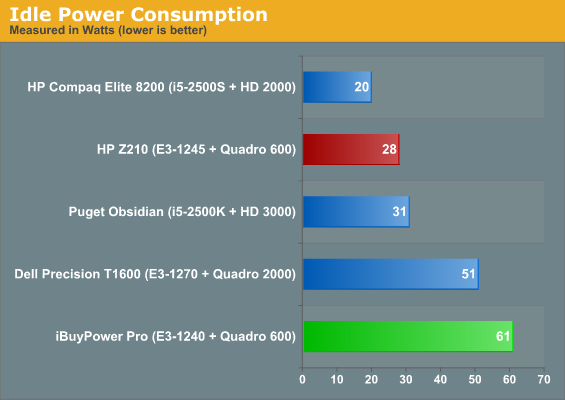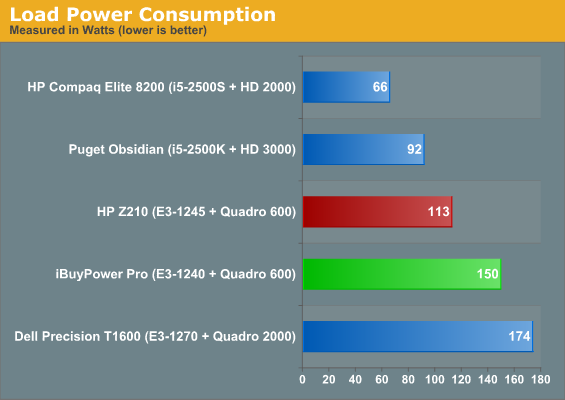iBuyPower Professional Series: Reversal of Fortune
by Dustin Sklavos on October 21, 2011 1:15 AM ESTBuild, Noise, Heat, and Power Consumption
Unfortunately, this is the section where iBuyPower's Professional Series falls flat on its face. The smaller custom chassis designs that HP and Dell employ are places where any boutique is going to have a hard time competing, but the Cooler Master Silencio 550 isn't doing iBuyPower any favors.

Internal build quality is certainly clean, and the noise dampening materials employed on the insides of the side panels don't hurt. In fact, under load the iBuyPower Pro is borderline inaudible...or at least it should be. The problem is that the hard drives are loud. Not even a little loud, either; they completely overwhelm the rest of the build. They're so close to the ventilation in the front that the noise from them isn't dampened at all, and whenever the iBuyPower Pro hits the RAID 1 you can hear them crunching. There's nothing in the character of the noise to suggest that the drives are malfunctioning, it's just a case of them being too noisy. I have to wonder if opting for a different brand of hard drive wouldn't have been a better choice.
The liquid cooling on the processor also strikes me as overkill. This is a fine checkbox feature for gaming desktops, but in a workstation it's an unnecessary expense. The rest of the enclosure has enough dampening that I don't see how Intel's stock cooler would be that much of a drawback. It's nice for iBuyPower to include this as standard, but in workstation desktops from OEMs it's unnecessary; their custom chassis designs allow them to dissipate heat quietly and efficiently.

The iBuyPower system's thermals aren't terrible but they still manage to underwhelm. I suspect part of the reason is that the Silencio 550 may have two intake fans in the front, but with the front door closed there's virtually no way for air to get into those fans. It runs into the same problem NZXT's H2 does. For a system with a mid-tower enclosure and liquid cooling on the processor, you'd expect a little bit better. The temperatures on the Quadro 600 in particular aren't great; 70C under load seems a touch high for such an underpowered card in a relatively open case.


Idle consumption of 61 watts certainly isn't bad for a desktop, but every other system we've tested does better, and HP's system is able to run at half that. The bigger case, bigger motherboard, liquid cooler, and dual hard drives take their toll on power consumption. It's only when we get to load power that Dell's significantly faster Precision T1600 pulls more juice, and even then it's not a massive gulf. For roughly the same performance, HP's Z210 pulls less than half the power at idle and 75% of it at load.















21 Comments
View All Comments
greylica - Friday, October 21, 2011 - link
The Ge forces uses the same cores of the Quadros, but are are hardware and software hacked by Nvidia to separate ''content consumers'' from ''content producers''. They separate them as having money to work or not having money to work. Same thing from ATI and their FireGL Cards. You can find searching in the internet that a GTX 285 is faster than a GTX 580 in OpenGL applications. For example: some folks are so irritated with this that made a hack to GL read Pixels. When GTX 580 launched, I tought ''OOOOHHH'' Awewsome specs ! Then I said ''OOOOOHHHH'' slower than GTX 285 ???Bought 2 used GTX 285 and I'm very happy using my Linux Workstation with Blender...
Quadros with the same power as a GTX 285 in OpenGL are 4X more expensive, why Nvidia ? 2X the price isn't enough ???
Nvidia said that they won't fix their drivers for GTX 580, it's clear that they want to separate consumers from producers, but GTX 580 isn't the best card to compare with Quadros. The problem started with GTX 480...
jamyryals - Friday, October 21, 2011 - link
Obviously the enterprise cards have different optimizations than the consumer brethren. The extra costs for enterprise GPU cards are for driver validation testing/support. In consumer cards you have many more people sharing those costs.Simple as that. It's not gouging, it's what the have to charge to make a profit in that business.
1 day of avoided downtime will pay for the extra cost. If something goes wrong you can get someone on the phone and get immediate service. Enterprise support is vastly underrated by many people, but it's extremely important to minimize risks to a delivery schedule.
Stuka87 - Friday, October 21, 2011 - link
I am going to assume that you don't work in the industry that makes use of professional grade cards such as the Quadro and FireGL.There are hardware differences, but the biggest difference is i the drivers. The drivers go through a great deal of testing, and get certified to work properly with the software that they are typically used with (Such as AudoCAD, SolidWorks, etc). The drivers are also not always in a constant state of flux. Updates come less often, so they are far more stable.
I have no problems with the pro cards costing far more when it means there wont be compatibility or crashing issues. You using GTX cards for Blender is fine. But if you are running a business you can't afford to take chances like that. Things need to work, and they need to work the same way day in and day out.
greylica - Friday, October 21, 2011 - link
Ok, I Work everyday with different equipments and I can tell that there is not a single problem in years using the combination Blender + Linux + Good OpenGL Cards. Believe it or not, I have a flickering problem With a Quadro FX3450 using Nvidia Quadro drivers that does not appear in GTX 285 using Subsurf Level 5 with a big displacement map.*''1 day of avoided downtime will pay for the extra cost.''
Agree, but some problems appear even with Quadros, and the only perception I have in years is that decent cards like 2XX series and OpenGL drivers are stable enough but performance are downgraded artificially in drivers in a manner that separates creators from consumers. After 4XX series, OpenGL performance are thrown in an abysm. Thanks to good (free software) coders, those problem doesn't affect conformant renderers running in CPUs or Multiple Small cores (OpenCL), and the only limitation we have for now is the fact that a big map can sometimes suffer from laggies. Thanks again to good (free software) coders, we can decimate visualization and turn Subsurf on for the Render time only. And Thanks again to good coders, we are now aware of the problems that are present in 4XX and 5XX cards, or others from now and up that are OpenGL performance hacked.
lockheart - Friday, October 21, 2011 - link
Does IBP give a retail version of Windows 7 or do they supply an OEM DVD type recovery disk like other major manufacturers do? A lot of times we'd like to use Microsoft tools like ImageX and Windows AIK to make images of our operating systems and with OEM DVDs this is not possible due to the way the license keys work.haxor911 - Friday, October 21, 2011 - link
They should have put quieter drives; but I think this is being marketed as a workstation not a desktop. The Dell Precisions we have here come with 15k RPM SAS drives and they sound like they are grinding rocks when working with large files.wyrmslair - Friday, October 21, 2011 - link
Yes, very few people overclock a Xeon workstation but many, many workstation users push their CPU's to the limit over long periods with rendering or other CPU intensive tasks. Trust me when I say that the advantages of a LC over AC system will show for many workstation users. How do I know this? I used to do these kinds of configurations for a boutique shop that serviced that industry and I was getting it straight from the horse's mouths. Most engineers and graphic artists (this was back when video rendering actually needed horsepower) where very aware of how well cooled or ventilated their systems were and had horror stories of overheating at some point. From what I still hear, things have not changed much in that respect in the WS market.Other than that, good job on showing how the boutiques can compete and do decent job of it even with their inherent weaknesses.
IdBuRnS - Monday, October 24, 2011 - link
"but oftentimes the end user will be better off going to a boutique like iBuyPower for their desktop and enjoying the generally superior build and component quality along with better customer service."ibuypower's customer service is freaking horrendous.
They deliver computers that have disconnected internal components, BSOD repeatedly upon first boot and when they promise to replace the computer after a multiple issues they just send the exact same computer back to you (on your dime) without any of the issues resolved and claim they never said they would replace the system in the first place.
They suck and you guys keep reviewing their systems and giving them good scores.
Adelwich - Wednesday, October 26, 2011 - link
After extensively reviewing the components, I pulled the trigger on an ibuypower system that arrives tomorow. This thread, combined with similar threads elsewhere, gives me the fear and makes me wonder if i blew it.Am I doomed?Drittz121 - Friday, February 28, 2014 - link
Just do yourself a favor. STAY AWAY from this company. Yes they look good. But when it breaks and it WILL. All they do is give you the run around. They have had my system for over 2 months trying to fix the garbage they sell. Worse company out there for support. DONT BUY